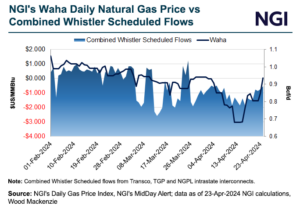Cooler Forecasts and Broader Demand Concerns Weigh on August Natural Gas Futures
- Absent other demand catalysts, a modest pullback in the intensity of heat expected by forecasters was enough to push down August natural gas futures
- Increased spread of the coronavirus in recent weeks has raised concerns about a second economic slump
- Against that backdrop, worries about meager export levels linger
Absent other demand catalysts, a modest pullback in the intensity of heat expected by forecasters was enough to push down August natural gas futures on Monday as coronavirus concerns and worries about meager export levels lingered.

The August Nymex contract declined 7.7 cents day/day and settled at $1.641/MMBtu. Futures were off more than 10 cents for a stretch of the trading day. September fell 8.1 cents to $1.684.
NGI’s Spot Gas National Avg. lost 6.5 cents to $1.620.
Bespoke Weather Services said Monday its forecast tilted cooler over the weekend, with total projected gas-weighted degree days (GWDD) for the week ending Friday sitting at 93, still above normal for the comparable week for the last five years of 84 GWDDs but down from more than 100 a few days earlier.
Expectations for the current week have “moved notably cooler compared to what it looked like a week ago,” Bespoke said. “The bias of the modeling has been to forecast too much heat, especially in the Midwest. For this reason, we have undercut the projected GWDD in the modeling even beyond this week. We remain confident in a hotter-than-normal pattern continuing into August, but the model bias remains a glaring one.”
Having previously predicted that the current month could set a July record, Bespoke added, “We now project that this month will fall short of both July 2011 and July 2012 as far as total GWDDs.”
The forecaster noted that liquefied natural gas (LNG) volumes were up modestly to start the trading week but so too were production levels. Power burns were strong in absolute terms over the weekend, but they were “a little less impressive” than the prior weekend on a weather-adjusted basis, Bespoke said.
Ongoing and increased spread of the coronavirus in recent weeks has raised concerns about a second economic slump domestically and abroad, after signs of recovery in May and into June. Officials across several states and numerous major cities, from Los Angeles to Miami, have either paused reopening plans or are considering doing so. Restrictions imposed to slow spread of the virus would likely dampen commercial and industrial energy demand again, before being fully able to bounce back from economic shutdowns imposed in the spring.
Similar concerns permeate parts of Europe and Asia, which are key destinations for U.S. LNG exports. Observers now say that the specter of protracted LNG demand weakness puts the onus on robust heat for the balance of summer to drive cooling demand and ward off containment challenges in the fall.
Near term, “the market continues to be spooked by the threat of late-season bearish demand shocks and exceeding available storage capacity,” EBW Analytics Group said. “Until these concerns abate, natural gas may struggle to exceed sub-$2.00/MMBtu levels.”
The U.S. Energy Information Administration (EIA) reported an injection of 45 Bcf for the week ending July 10, which was lower than the average of major polls and bullish relative to the 67 Bcf storage build in the same week in 2019 and the five-year average injection of 63 Bcf.
Analysts said the latest injection result showed that high July temperatures were driving cooling demand and starting to address imbalances caused by the pandemic. They also noted that, with the virus resurging and a return of LNG under threat, summer heat stands alone as the near-term demand driver.
“Bears continue to win the battle between bearish fundamentals (weak LNG, hefty supplies, recovering production) versus bullish weather as prices are now down more than 15% in less than a week,” NatGasWeather said Monday.
If the remainder of summer proves cooler than the first half of the season, containment could become an issue. The most recent storage injection lifted inventories to 3,178 Bcf, up from the year-earlier level of 2,515 Bcf.
Absent exceptional weather-driven demand, “inventories likely continue to expand” and “set up for a capacity crunch this fall, which drives a downward skewed risk-return profile for the balance of injection season,” Tudor, Pickering, Holt & Co. analysts said.
Cash Lower
Spot prices fell across much of the Lower 48 despite still-lofty temperatures.
NatGasWeather said while forecasts cooled some over the weekend, strong summer conditions are still expected across much of the country.
“With heat indexes into the 100s over the southern and eastern U.S. the next few days, national demand will be quite strong,” the firm said. “Demand will be aided also by hot conditions over the Northwest early this week as highs reach the 90s.
“There are cooler exceptions across the northern Plains and Midwest as weak weather systems/cool fronts track through with showers and highs of comfortable 70s to 80s,” the forecaster added. “By late this week, the hot dome of high pressure will shift over the west-central United States, with highs of 90s and 100s continuing across much of the country for continued strong demand.”
While the hot ridge shifting into the central part of the country “does open the door for weak systems to slide into the Northwest and Northeast at times,” overall it remains “a very warm to hot pattern.”
Substantial decliners included Algonquin Citygate, down 15.5 cents day/day to average $1.665, and Chicago Citygate, down 12.0 cents to $1.575.
Elsewhere, Carthage lost 7.0 cents to $1.575, and Columbia Gas lost 6.5 cents to $1.475.
Exceptions included Texas Eastern M-3, Delivery, up 7.0 cents to $2.000, and SoCal Citygate, up 3.5 cents to $1.880.
© 2024 Natural Gas Intelligence. All rights reserved.
ISSN © 2577-9877 | ISSN © 2577-9966 |


